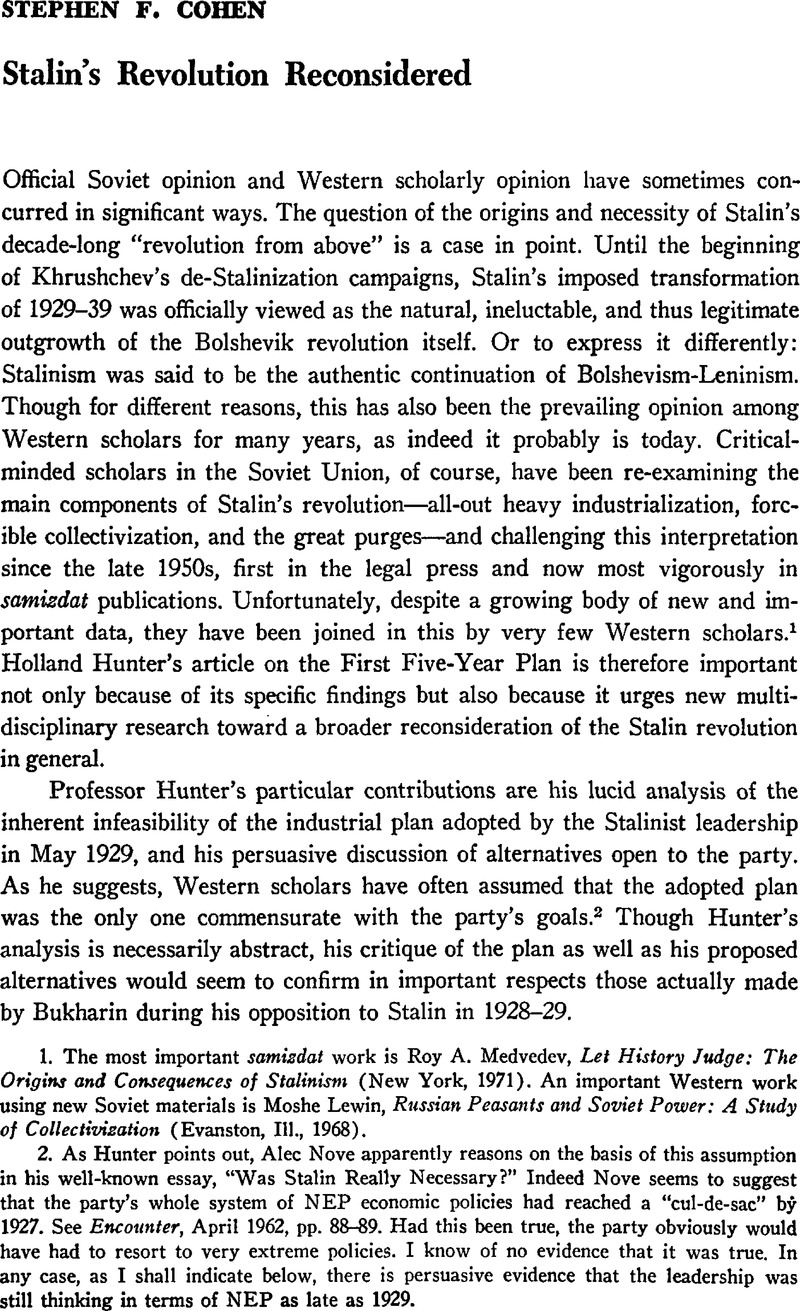Article contents
Stalin's Revolution Reconsidered
Published online by Cambridge University Press: 27 January 2017
Abstract

- Type
- Discussion
- Information
- Copyright
- Copyright © Association for Slavic, East European, and Eurasian Studies. 1973
References
1. The most important samizdat work is Medvedev, Roy A., Let History Judge : The Origins and Consequences of Stalinism (New York, 1971)Google Scholar. An important Western work using new Soviet materials is Moshe, Lewin, Russian Peasants and Soviet Power : A Study of Collectivisation (Evanston, III., 1968)Google Scholar.
2. As Hunter points out, Alec Nove apparently reasons on the basis of this assumption in his well-known essay, “Was Stalin Really Necessary?” Indeed Nove seems to suggest that the party’s whole system of NEP economic policies had reached a “cul-de-sac” bẏ 1927. See Encounter, April 1962, pp. 88-89. Had this been true, the party obviously would have had to resort to very extreme policies. I know of no evidence that it was true. In any case, as I shall indicate below, there is persuasive evidence that the leadership was still thinking in terms of NEP as late as 1929.
3. The fullest statement of Bukharin’s objections to Stalin’s policies is his “Zametki ekonomista,” Pravda, Sept. 30, 1928, pp. 2-3. See also his “Tekushchii moment i zadachi nashei pechati,” Pravda, Dec. 2, 1928, pp. 3-4, and “Lenin i zadachi nauki v sotsialisticheskom stroitel'stve,” Pravda, Jan. 20, 1929, pp. 2-3.
4. Professor Hunter does not discuss the plan in connection with agriculture. I shall follow his example here, but it should be remembered that agrarian policy was central to the struggle between Bukharin and Stalin in 1928-29.
5. See his forthcoming book, Political Ideas in Soviet Economic Debates : From Bukharin to Modern Economic Reformers, to be published in 1974 (Princeton, N.J.).
6. Medvedev, Let History Judge, pp. 101-9; and Leonid Petrovsky’s open letter to the Central Committee, translated in the Washington Post, Apr. 27, 1969, pp. C1, C5.
7. Alexander, Erlich, The Soviet Industrialization Debate, 1924-1928 (Cambridge, Mass., 1960), chap. 4.Google Scholar
8. Cohen, Stephen F., Bukharin and the Bolshevik Revolution : A Political Biography, 1888-1938 (New York, 1973).Google Scholar
9. On the question of relative organizational strength, suffice it to note that in mid- 1928 a majority of the members of the Orgburo, a presumed Stalinist stronghold, were Bukharin’s supporters. See Vaganov, F. M., Pravyi uklon v VKP(b) i ego razgrom (1928-1930 gg.) (Moscow, 1970), p. 144 Google Scholar.
10. The term is Molotov’s. See Bolshevik, 1931, no. 3 (February 15), p. 20.
11. Valuable sources for such a study include Valentinov, N. (Vol'sky), Novaia ekonomicheskaia politika i krizis partii posle smerti Lenina : Gody raboty v VSNKh vo vremia NEP (vospominaniia) (Stanford, 1971)Google Scholar; Kuibysheva, G. V. et al., Valerian Vladimirovich Kuibyshev : Biografiia (Moscow, 1966)Google Scholar; and Khavin, A. F., U rulia industrii (Moscow, 1968).Google Scholar
12. Istoricheskii arkhiv, 1961, no. 5, p. 109.
13. Shestnadtsataia konjerentsiia VKP(b) aprel’ 1929 goda : Stenograficheskii otchet (Moscow, 1962), p. 214. See also Khavin, U rulia industrii, pp. 67-68.
14. See, for example, Stalin, J. V., Works, 13 vols. (Moscow, 1952-55), 11 : 217, 257, 290-93.Google Scholar
15. Or as an official editorial on the plenum and the defeat of the Bukharin group said, “NEP is the only correct policy of socialist construction” (Pravda, Apr. 28, 1929, p. 1). For the economic resolutions of the plenum see KPSS v rezoliutsiiakh i resheniiakh s"ezdov, konferentsii i plenumov TsK, vol. 2 (Moscow, 1954), pp. 569-89.
16. I am arguing that by the mid-twenties NEP had achieved a general consensus and legitimacy among Bolshevik leaders as the proper transition to socialism. Some indication of this is the fact that two years after NEP's forcible abolition, the Stalinist leadership was still proclaiming its existence. See “NEP eshche ne zakonchen,” Pravda, Mar. 21, 1931, p. 1.
17. See, for example, Stalin, Works, 11 : 13, 62, 72-73, 81, 85, 226-27, 233, and 12 : 41, 221-22. Warlike approaches to social problems seem to have been congenial to what Tucker has called Stalin’s “warfare personality.” For this and the influence of the civil war on Stalin see Tucker, Robert C., The Soviet Political Mind, revised ed. (New York, 1971), pp. 40–41 Google Scholar, and his Stalin as Revolutionary, 1879-1929 : A Study in History and Personality (New York, 1973).
18. Stalin, Works, 11 : 62, 179-80. Bukharin had a different conception of class strug gle, arguing that progress toward socialism required and presupposed a diminishing of class conflict. See, for example, his Politicheskoe zaveshchanie Lenina, 2nd ed. (Moscow, 1929), pp. 9-10, 20-23.
19. A., Kosarev, Komsomol v rekonstruktivnyi period (Moscow, 1931), p. 58 Google Scholar; Ocherki istorii Kommunisticheskoi partii Ukrainy, 2nd ed. (Kiev, 1964), p. 401. The indispensable study of these events, and of this period in Soviet history generally, is Lewin’s Russian Peasants and Soviet Power, chaps. 13-17.
20. In June 1930, as Medvedev points out, Stalin “dismissed as ‘hopelessly bureaucratic’ the argument that such arbitrary increases undermined the whole principle of planning.” Stalin was obviously responding to high-level objections. See Medvedev, Let History Judge, p. 103. The nature of the Second Five-Year Plan, in light of what had happened during the first, became a source of conflict within the Stalinist leadership in 1932-33.
- 2
- Cited by


